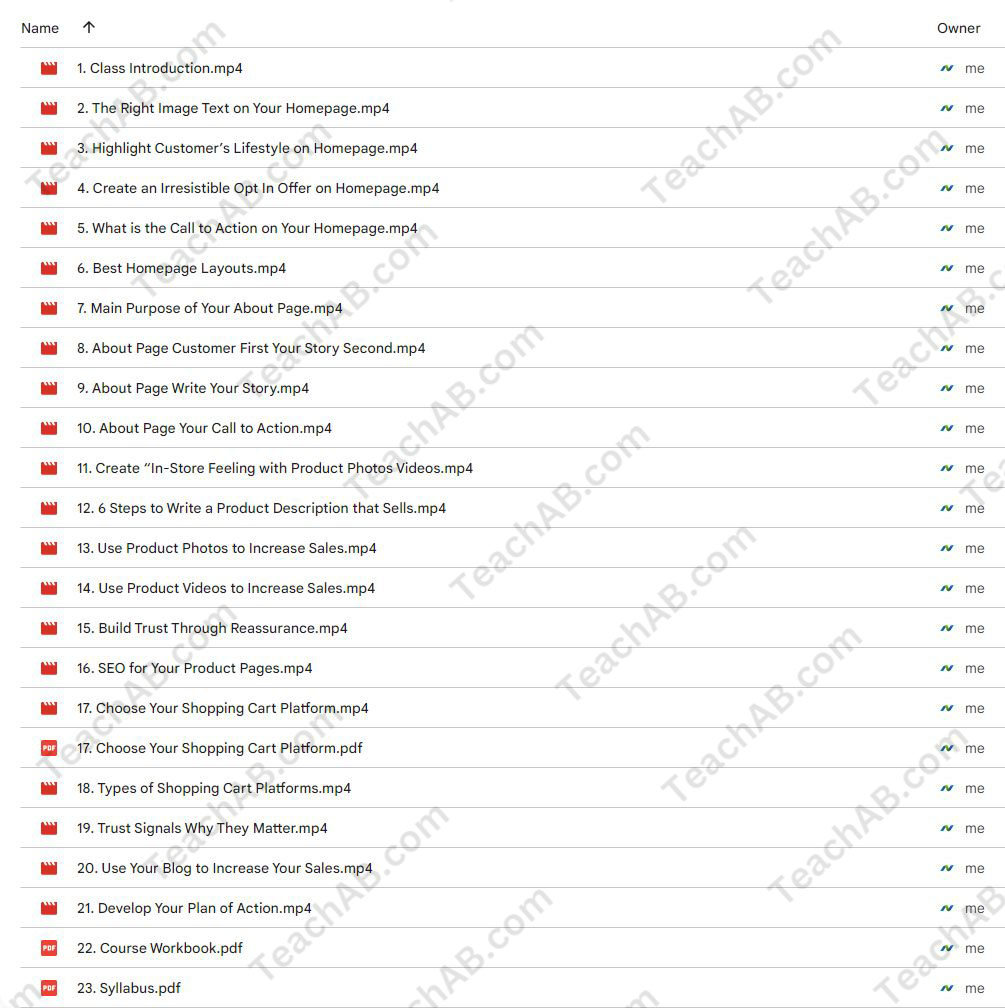-
×
 RMF ISSO Foundations Course - Bruce Brown
1 × $62.00
RMF ISSO Foundations Course - Bruce Brown
1 × $62.00
Optimize Your Online Store By Andreea Ayers
$24.00 $5.00
SKU: C55.539723op3iJ
Category: Business
Tags: Andreea Ayers, Online Store, Optimize Your Online Store
Optimize Your Online Store: A Comprehensive Review
Content Proof:
In today’s digital age, launching an online store is more than just setting up a website. It requires a strategic touch, creativity, and a deep understanding of consumer behavior. One course that stands out in this domain is “Optimize Your Online Store” by Andreea Ayers. This course offers invaluable insights for entrepreneurs seeking to elevate their e-commerce platforms.
With a wealth of experience from launching and selling multiple businesses, Ayers brings a unique perspective to the table. She guides learners through the intricacies of online retail, from crafting a captivating homepage to establishing trust with customers through effective storytelling. In this review, we will explore the key aspects of the course and the transformative potential it holds for aspiring online store owners.
Creating a Welcoming Homepage
The homepage is often described as the digital storefront of an online business. It’s the first impression potential customers have, and as such, its design is crucial. Ayers emphasizes that an engaging homepage layout plays a vital role in capturing visitors’ attention. But what makes a homepage engaging? She suggests that it’s all about the strategic blend of the right images and compelling text. These elements must work harmoniously to evoke emotions and spark curiosity.
Elements of an Effective Homepage
To illustrate Ayers’ point, let’s delve into the core components that contribute to an effective homepage:
- Visual Appeal: High-quality images that represent your brand effectively.
- Clear Navigation: Intuitive menus that make it easy for users to find what they need.
- Strong Headline: A headline that grabs attention and communicates your value proposition.
- Call-to-Action (CTA): Prominent buttons encouraging users to take specific actions, such as “Shop Now” or “Learn More.”
For instance, consider a high-end fashion retailer’s homepage. The use of striking visuals that showcase the latest collection, combined with a succinct headline that encapsulates the brand’s ethos, can create an inviting atmosphere. This layout not only entices customers to browse but also facilitates deeper engagement with the products.
Emotional Connection with Customers
Ayers further posits that establishing an emotional connection through storytelling on the homepage is imperative. When visitors feel a connection to a brand, they are more likely to explore further and consider making a purchase. An effective way to tell your brand story is through the ‘About’ page.
Building Trust: The Importance of an About Page
In an era where skepticism towards online shopping is prevalent, building trust is essential. Ayers emphasizes the need for an impactful ‘About’ page, which serves as a bridge between the brand and its customers. This page should not only narrate the brand’s story but also include elements that foster trust.
Key Features of a Trustworthy About Page
- Brand Story: Share the journey of how your brand came to be, including challenges and milestones.
- Founder’s Background: Provide insight into the founders and their passion for the industry.
- Customer Engagement: Integrate testimonials or user-generated content that reflects customer satisfaction.
- Trust Signals: Incorporate elements such as awards, certifications, or mentions in reputed publications.
A well-crafted ‘About’ page can significantly enhance a customer’s perception of the brand. For example, a small artisan coffee brand can leverage its founder’s story of learning the craft in a distant coffee farm to establish authenticity. This narrative can resonate with consumers on a personal level, encouraging them to support the business.
Compelling Product Descriptions and Visuals
While the homepage and ‘About’ page are pivotal, product descriptions play an equally crucial role in the purchasing decision. Ayers offers actionable strategies for writing product descriptions that can captivate potential buyers. She stresses the importance of focusing on benefits rather than just features.
Crafting Product Descriptions That Sell
To create compelling descriptions, consider the following approaches:
- Highlight Benefits: Explain how the product solves a problem or enhances the customer’s life.
- Use Imagery: Incorporate vivid language that helps customers visualize the product in their lives.
- Include Specifications: Provide necessary details, such as dimensions, materials, or usage instructions, in an organized manner.
Example Breakdown of a Product Description
| Feature | Description |
| Product Name | Organic Cotton T-Shirt |
| Benefits | Soft, breathable fabric that is gentle on the skin; perfect for casual wear or workouts. |
| Visual Imagery | Picture yourself lounging at home or enjoying a sunny day in the park, comfortably dressed in this T-shirt. |
| Specifications | Available in sizes XS-XL; machine washable; made in ethically responsible conditions. |
By focusing on these aspects, entrepreneurs can create product descriptions that not only inform but persuade. When combined with high-quality images and videos, the likelihood of conversion increases significantly.
Selecting the Right Shopping Cart Platform
No online store can thrive without a competent shopping cart platform. Ayers provides insights into selecting an appropriate system that aligns with the store’s needs. This aspect is frequently overlooked, yet it can greatly affect user experience and business efficiency.
Key Considerations for Shopping Cart Selection
- User Interface: Ensure the cart is easy for customers to navigate.
- Integration Capabilities: Check compatibility with payment gateways and inventory management tools.
- Mobile Responsiveness: With an increasing number of purchases made via mobile, the platform must perform seamlessly across devices.
- Cost and Features: Assess the pricing plans relative to the features offered.
Consider a comparison between popular shopping cart platforms:
| Platform | Monthly Cost | Key Features |
| Shopify | Starts at $29 | User-friendly, vast app marketplace |
| WooCommerce | Free (with hosting) | Highly customizable, open-source |
| BigCommerce | Starts at $29.95 | Advanced SEO features, unlimited products |
| Squarespace | Starts at $18 | Visually stunning templates, integrated blogs |
Choosing the right platform can set the foundation for a smooth shopping experience, which in turn can lead to higher conversion rates.
SEO Strategies for Product Pages
In today’s competitive online landscape, merely having a well-designed store is not enough; it needs visibility. Ayers emphasizes the importance of applying specific SEO techniques for product pages to increase traffic and improve search rankings.
SEO Techniques to Implement
- Keyword Optimization: Research and incorporate relevant keywords into product titles, descriptions, and meta tags.
- Alt Text for Images: Utilize descriptive alt text for product images to aid in search engine indexing.
- Product Reviews and Ratings: Encourage customers to leave reviews; they can enhance SEO performance and establish credibility.
- Internal Linking: Create links between related products to improve navigation and boost SEO.
By implementing these strategies, online store owners can ensure their products are discoverable, allowing them to reach a broader audience.
Conclusion
In summary, Andreea Ayers’ course on optimizing online stores presents a comprehensive framework for entrepreneurs aiming to enhance their e-commerce platforms. From the initial homepage design to effective product descriptions, trust-building measures, and SEO strategies, every aspect is thoughtfully addressed. For anyone serious about carving out a successful online retail presence, “Optimize Your Online Store” offers the tools and insights needed to thrive in an ever-evolving market. With practical advice and actionable strategies, learners are well-equipped to turn their visions into reality, engaging customers and driving sales effectively.
Frequently Asked Questions:
Business Model Innovation: We use a group buying strategy that enables participants to share costs and access popular courses at lower prices. This approach helps individuals with limited financial resources, although it may raise concerns among content creators regarding distribution methods.
Legal Considerations: Our operations navigate complex legal issues. While we do not have explicit permission from course creators to resell their content, there are no specific resale restrictions mentioned at the time of purchase. This lack of clarity allows us to offer affordable educational resources.
Quality Control: We guarantee that all course materials provided are identical to those offered directly by the creators. However, please note that we are not official providers. As a result, our services do not include:
– Live coaching calls or sessions with the course author
– Access to exclusive author-controlled groups or portals
– Membership in private forums
– Direct email support from the author or their team
Our goal is to make education more accessible by offering these courses independently, without the additional premium services available through official channels. We appreciate your understanding of our unique approach.
Be the first to review “Optimize Your Online Store By Andreea Ayers” Cancel reply
You must be logged in to post a review.



















Reviews
There are no reviews yet.